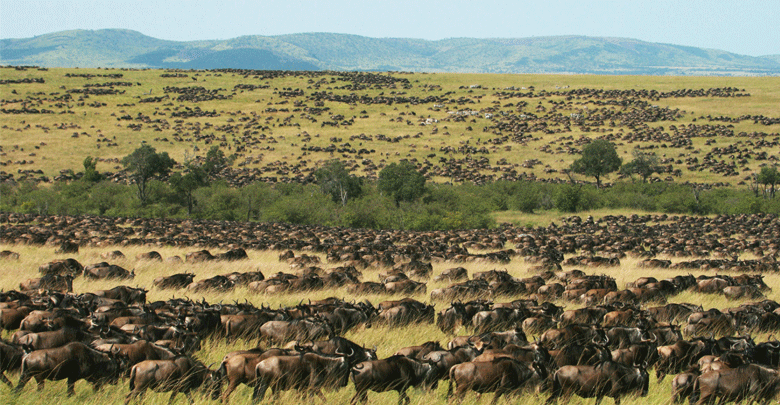Will the Mara survive vast ecosystem harm?

The national reserve is an important ecological phenomenon and massive tourist attraction. However, it continues to shrink leading to biodiversity loss, and putting tourism in jeopardy.
The recent closing of Mara Ngenche camp, built along Mara River one of the main wildebeest migratory corridor brings to the spotlight again concerns ecologists have raised concerning the survival of the Mara-Serengeti ecosystem, especially, among many other reasons, the haphazard mushrooming of tourist facilities along the Mara River.
Last week, the National Environment Management Authority (Nema) closed the luxury camp, located at the confluence of two rivers in the reserve, after a video emerged showing its staff chasing away hundreds of wildebeests, which had crossed into the facility.
The camp will remain closed until an environmental impact assessment is done afresh to ascertain if it was built in a migratory corridor.
The events at Masai Mara are unfolding at a time when a newly released report shows that Africa has suffered 65 per cent decline in wildlife populations in the past 50 years.
This is blamed on a number of factors, which also included the ongoing fencing of group ranches bordering Masai Mara National Reserve, poaching and general environmental degradation of ecosystems supporting the sustenance of the reserve, therefore threatening its survival.
According to the 2020 Living Planet report by World Wide Fund for Nature, WWF, change in land use is the biggest factor contributing to plummeting numbers of animal species.
“In Masai Mara for instance, building of tourist facilities along the Mara and Talek rivers has blocked animal migratory paths leading to shrinking numbers of wildebeests crossing between Kenya and Tanzania,” says the report.
Some wildlife species, according to ecologists, have started disappearing from their known habitats, illustrating that if nothing is done to control developments in and out of protected areas and stop fencing by giving landowners incentives, the world’s famous game reserve will be on the verge of losing its allure.
Changes in land use leading to modification of the environment in which species live in have already contributed to 46 per cent decline in wildlife populations in Africa, Living Planet report shows.
Nancy Githaiga, Head of Conservation Programmes, WWF says humanactivities including unsustainable agriculture, residential and commercial development and logging have altered species key habitats.
Conservationists say before the mushrooming of camps and lodges along Mara River, wildebeests to and from Serengeti in Tanzania and to and from the Mara Triangle used to freely cross from any point of the crocodile-infested river.
They are worried by the land-use changes outside the park, warning that if not halted, it will fast accelerate the death of the reserve.
Data shows that numbers of tourist lodges and beds available for tourists in the reserve increased by 500 per cent and 366 per cent respectively between 1988 and 2013.

After subdivision of parcels of land, some individuals have rented their land for other purposes apart from wildlife conservation, such as agriculture.
“Over time more land in crucial animal habitats has been put under agricultural use.
We need to think about ways of producing our food sustainably, especially given that one third of the food produced for human consumption goes to waste,” notes Nancy.
Some sections, which used to act as migratory corridors, habitats or breeding gorges are now cattle grazing fields, thus fuelling human-wildlife conflict.
Mara Management Plan
The proliferation of poison substances, including banned pesticide Furadan, is in the hands of herders, putting lives of lions, spotted hyenas, leopards and cheetahs, which prey on livestock in grave danger.
Conservationists have for years called for formulation of Mara Management Plan to control developments inside and outside protected areas without success.
Tourism Cabinet Secretary Najib Balala is among the latest entrants to call for formulation and enforcement of the management plan to control activities, which threaten the survival of flora and fauna in the reserve.
More than 200,000 resident wildebeests are now unable to cross from Loita plains to the park and conservancies because of fencing.
Dickson Kaelo, the Kenya Conservancies Association CEO is worried about the shrinking corridors, adding that people neighbouring the park should be given more incentives to abandon fencing and change land use.
Breeding grounds for wildebeests in Olkinyei area, near the park, he says, are also shrinking. Migratory animals preferred the area because there were few predators.
But cattle keepers push away the animals for fear of their livestock contracting the deadly Malignant Catarrhal Fever (MCF) after grazing in areas where the wild animals calved from.
Incentives to locals
Kaelo says about 500,000 livestock roam and graze inside and outside the protected areas every year, despite laws against grazing.
He adds that the absence of direct benefits from the multi-billion shilling industry contributes to locals keeping large herds of cattle for income.
“For cattle to co-exist peacefully with wildlife, a quick formula between the county government, hoteliers and conservancies to ensure there is commensurate benefits sharing should be worked out,” he says.
He adds that locals view tourism as a preserve of a few, making them care less about conservation matters.
Almost all hotels are owned by people outside the community and only a few are run by locals, and they are not doing well.
“To have locals appreciate conservation, their parcels of land should be merged to form big conservancies where members will be earning good money from tourism. It will also discourage them from keeping large herds of cattle,” he says.

Conservation of the world-famed reserve received a severe beating again recently when the National Land Commission (NLC) gazetted the setting aside of 1,300 acres of land for setting up of a military facility at Olkinyei area, which is a wildlife dispersal, a breeding ground and habitat area.
“Many aspects of conservation were not considered when the decision was being made,” says Nick Murero, the chairman of Narok Environment and Wildlife Forum.
Agricultural activities aided by irrigation, especially along the Mara River, he says, has also led to shrinking of wildlife dispersal corridors and access to water by wild animals.
“Large scale wheat, maize and horticulture farming is making it difficult for few animals neighbouring the farms to access water whose quality is compromised on a daily basis by use of pesticides and herbicides,” he says.
Unregulated irrigation
The level of water in the river that is the lifeline of the Mara-Serengeti Ecosystem, he says has been dropping because of unchecked irrigation.
Fenced large tracts of land also hamper wild animals from accessing the river.
Murero, who is also the coordinator of the Mara-Serengeti Ecosystem for Lake Victoria Basin, concurs that some species of wild animals have over the years disappeared because of encroachment on to their habitats.
“The capacity of the ecosystem is limited to a certain number of establishments.
The number of tourism facilities, which now stands at over 250 for less than 6,000 square kilometres, is too big,” says Murero.
He lays the blame squarely on Nema and the defunct Narok County Council for licensing them, saying if not pulled down, the premier Safari destination, which started losing its allure in early 1990s will become a big slum minus wildlife.
“Licences were given because of political conneCtions and money changing hands. What was done more than three decades ago, is now coming to haunt us,” he said.
Nema, he says is supposed to annually carry out environmental audit on camps and lodges to ascertain their suitability and wondered why it is now rushing to close one facility only yet there are many which fall in the same category.
The authority, he further claims gave licences to people who wanted to set up facilities from Nairobi without visiting the ground and asks the new chairman at Nema, John Konchella to right all the wrongs that were committed by his predecessors.
Patrick Lekenit, the immediate former Nema officer in charge of Narok county says most of the tourists facilities in the Mara were not established in strict environmental terms, aciting political interference.
Most of the facilities are in conservancies, which are private lands,” he says.
To which Narok Governor Samuel Tunai, agrees. He says says the county will review licenses of hotels in the Mara with a view to easing congestion.
The future of the Mara is also being eroded by mushrooming of trading centres outside the protected areas, charcoal burning, dumping of solid wastes and poaching.
Talek, Sekenani, Mara Rianda and Ololaimutia are some of the centres at close proximity to the park, which also pose a security challenge for visitors.
The council allocated plots to beneficiaries who put up semi- and permanent structures.
“Every time plans to pull them down are made politics are introduced, rendering the need to protect the Mara a big joke,” conservation agencies say. Additional reporting by Evelyn Makena














